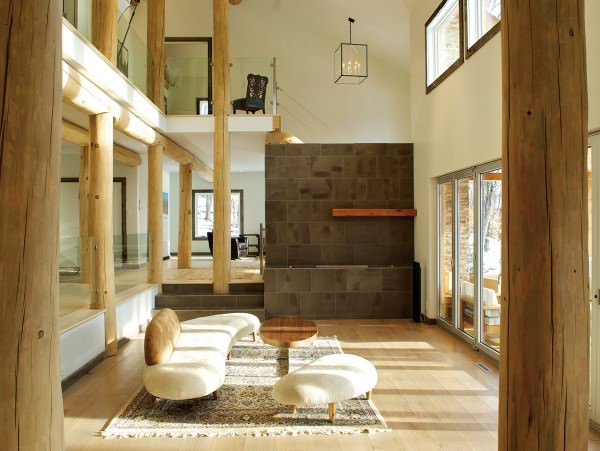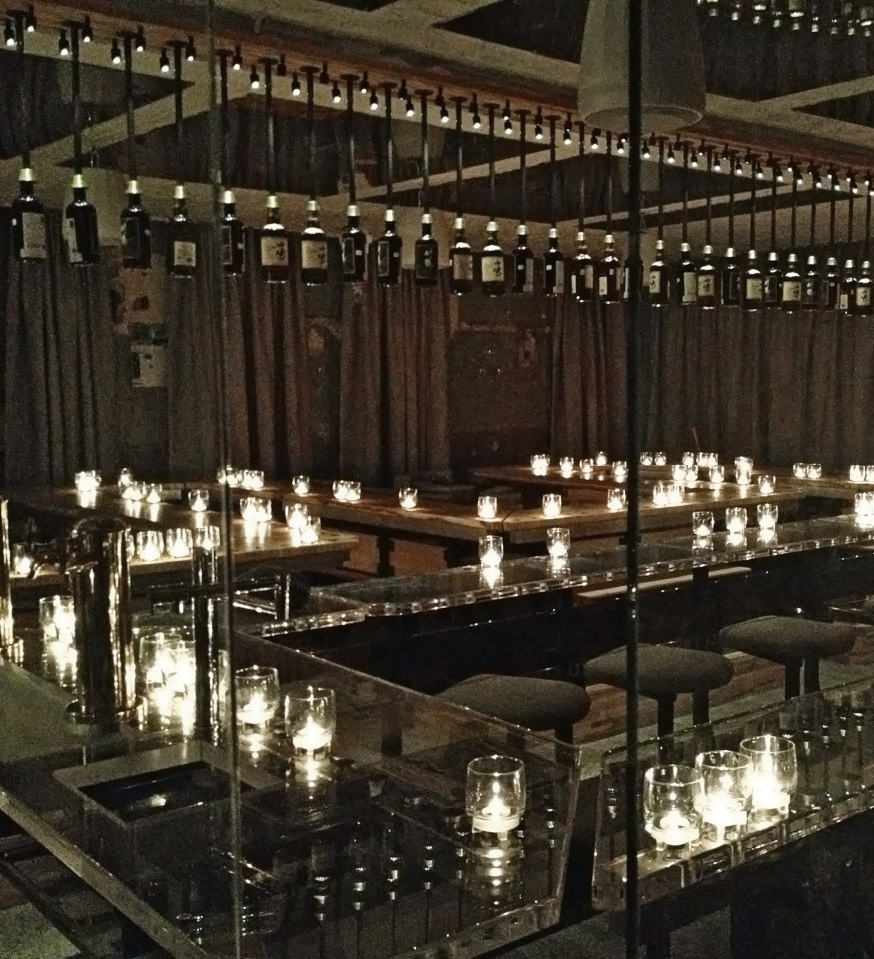Lac en Ciel in Mont-Tremblant, Quebec
A grand development.

With Tremblant ski resort in the distance, Lac en Ciel will be built upon 190 hectares in the Laurentian forest.
When visiting Mont-Tremblant for the first time, it can be hard to tell what’s real and what’s not. The landscape—spectacular, solemn—is a combination of mountains, trees, and lakes. This is Group of Seven country: rugged, rocky, and iconic.
But ever since Vancouver-based Intrawest arrived here 20 years ago, the region has taken on an air of unreality. Faux Swiss chalets now dot the hillsides, and an entire Alpine village has appeared. Canada’s largest resort developer wasn’t the first to recognize the appeal of the area—American Joe Ryan built Mont-Tremblant Lodge back in the late 1930s—but it was the biggest.
However, with the arrival of Matthew Shear and Steven Schiff, Intrawest may finally have met its match. The partners—presidents of Benjamins Group and Schiff Development respectively—have quickly established themselves as major players on the scene.
Called Lac en Ciel (Lake in the Sky), their grand project—and there’s no other word for it but grand—consists of a vast 190-hectare tract of virgin wilderness on which 100 custom houses will eventually be built. Each will sit on its own lot anywhere between 0.8 to two hectares in size. The views, of course, will be memorable, as will the properties. But for the time being, the rugged Laurentian forest remains remarkably untouched, trees towering over makeshift roads that wind up and down steep inclines. Even to the casual observer, it’s clear the potential is enormous. And given that accessibility is growing ever easier as airlines establish routes to the region, the appeal of Lac en Ciel seems ready to increase.
Shear, the driving force behind the project, is a Montreal-based developer who hails from Miami, Florida. His family moved from the United States to Quebec in 2006. As he makes clear, Lac en Ciel represented a unique opportunity. Until he bought it, the property had been owned by one family for nearly a century. That alone meant the land was relatively unspoiled, and, in this case, particularly well situated.
“We wanted a site that had a lake, as well as some high elevations,” Shear says. “My approach is look at the situation from a buyer’s point of view. I try to see what’s missing and fill in the voids.”
The properties start at $195,000, and buyers are expected to construct their own homes. The idea is that the homes will be designed to complement one another and blend in with the landscape, following a catalogue of detailed architectural guidelines. Shear says he doesn’t worry about having to set up Lac en Ciel design police; he expects owners will want to build something sympathetic, harmonious, and sustainable. Besides, he says, endless variations are possible within the limits that have been established. A board will review all exterior proposals, while interiors are up to the buyer. The minimum size for houses will be 3,000 square feet.
Lac en Ciel in Mont-Tremblant consists of a vast 190-hectare tract of virgin wilderness on which 100 custom houses will eventually be built.
In addition to reading the “rules”, potential buyers can check out a model home constructed offsite but nearby. Made of local materials—wood and stone—the house has a contemporary rustic look that makes sense in the context of Mont-Tremblant. Despite its heft, the building is fitted into a sloping site and thus avoids looming over the landscape. Exteriors are clad in wood and stone tiles, highlighted with large areas of glass.
Inside, the spaces are open and connected, rooms effortlessly flowing into others. The changes in level—demonstrated notably in a sunken living room—bring another layer of interest to the interior. Wandering around the house, it quickly becomes clear that one of the main design principles is a desire to take full advantage of the views—which are worth exploiting, as the topography encompasses mountains, valleys, and everything in between.
Architecturally, the house is broken down into a series of elements, with each room “visible” from the outside as a separate feature within the overall structure. As a result, the building doesn’t have the monolithic quality one might otherwise expect in such a large house. It’s another example of Shear’s desire to create a community at one with the landscape.
“People will appreciate what we’re trying to do,” he says. “We don’t want red roofs and metal siding. We have clear restrictions in terms of colour and materials. We don’t want to impact nature. We want to protect the integrity of the environment as well as ourselves. We want the houses to be very energy efficient and sustainable. They will be modern ecohomes that happen to be in the country. We will bring in the infrastructure—roads, telephones lines, fibre optics, and digital cable.” (It will be the owner’s responsibility to install their own well and septic system.)
Then there are Lac en Ciel’s amenities, which are also rooted in the landscape. Owners will share a number of unique features including their own toboggan run, ski hill, a leisure centre with a swimming pool, a sauna, and a Jacuzzi, and, best of all perhaps, their own private lake. Two lakes, in fact: Lac en Ciel and Lac du Sommet.
This is yet another way in which the project differs from conventional Mont-Tremblant developments, which comprise subdivisions full of condos. As Shear points out, “There are already a lot of condos in the area—it doesn’t really need any more.” No doubt about that; the biggest problem facing Mont-Tremblant could well be the sheer scale of growth. It could become a victim of its own popularity, a not uncommon fate for such regions.

Model home design for Lac en Ciel includes a sunken living room and a bio-ethanol fireplace by EcoSmart Fire.
The beauty of Shear’s scheme, of course, is that once it is built out, no further building can occur. Local bylaws dictate that no more than 20 per cent of green space on a property can be cleared to make way for development—although some charge that’s not enough, and complain that too much growth has already been approved. The bottom line is that the landscape remains the basis of the Mont-Tremblant economy; to ruin that would be to cut off its legs at the knees.
But the forces of development being what they are, slowing growth is easier said than done. Lac en Ciel has eliminated the problem by building conservation into the plan. Every property owner has a vested interest in preserving the natural splendour of the site.
“We have created the perfect development in the perfect location,” Shear says. “Residents will not have to leave the community except to ski on the mountain or attend a cultural event in Tremblant.”
If the attendance at the Lac en Ciel grand opening this past September was any indication, interest in the project is high. Several hundred people showed up on a rainy Saturday afternoon to tour the site, enjoy the views, and let their imaginations run wild. The property is still in virgin state; the trees are mature and the forest teems with life. Though it’s located only about 140 kilometres northwest of Montreal, it is a different world, a compelling blend of the raw and the refined.
Some question Shear’s timing; they wonder whether it makes sense to launch such a project at a time of widespread economic uncertainty. But, as he points out, “This is a perfect place for anyone who wants a country home. I looked at spots all over the world before I decided that Tremblant offered the best opportunity.”
Sitting at the foot of the mountain, the resort has a Disney-like feel; it isn’t quite what it appears. Full of condos, hotels, and shops, it’s more a place to visit than to live. And forget about being alone with nature; Tremblant is all about crowds. That can be fun, of course, but there comes a time when we want to return home and be alone.
“We’re trying to keep it lean and mean,” Shear says. “Tremblant is one of the top 10 ski resorts in eastern North America. More than $1.5-billion has been pumped into Mont-Tremblant by the province of Quebec and Intrawest.”
Shear expects his project will take six or seven years to complete. “There has been tons of traffic on weekends,” he says. “The interest level is high. The product has been accepted. We’re currently taking reservations.”




